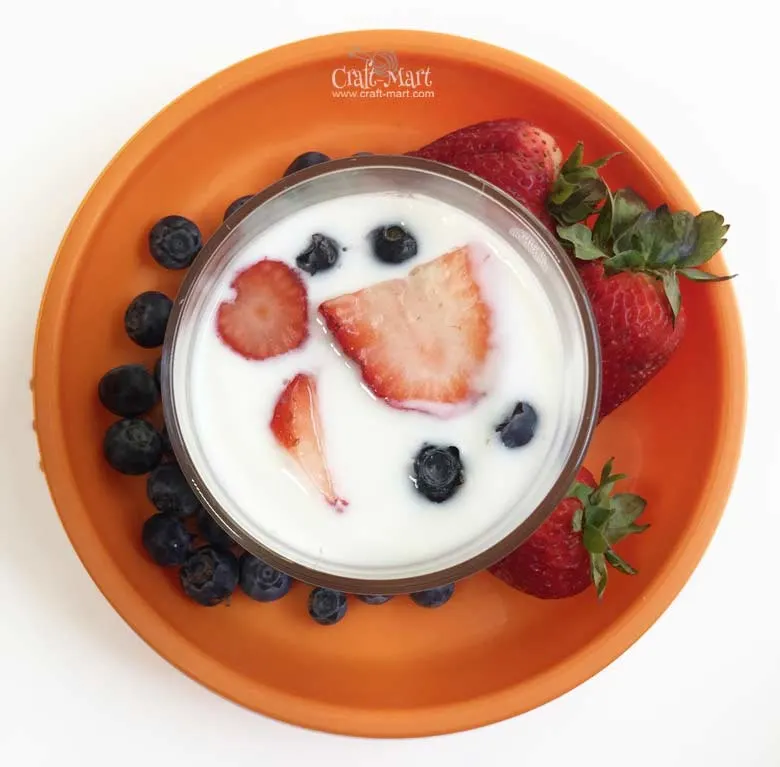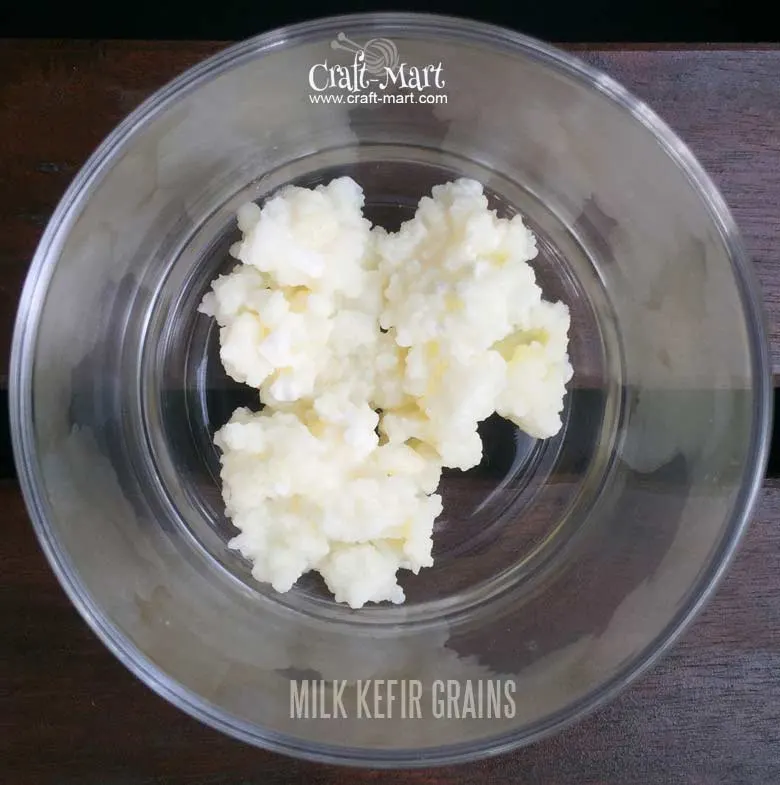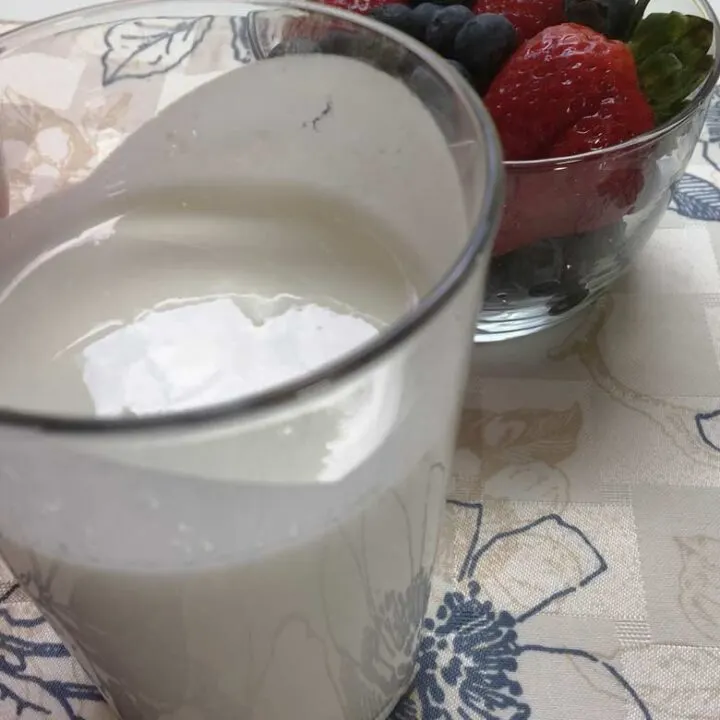If you are reading this post, you probably are already familiar with the extraordinary health benefits of homemade probiotic foods and drinks and ready to learn how to make kefir on your own instead of buying it at the store. With its popularity steadily growing, kefir is now available at your corner grocery stores.

This is a great development and is very helpful for health-conscious busy moms. But, if you desire to feed your family only the best organic kefir, you would have to make your own kefir from organic milk.
How to pronounce KEFIR correctly?
Since Kefir is a pretty new and exotic drink for many westerners, it is a very common mistake to pronounce its name as KEE-fer ( similar to famous Kiefer Sutherland).
Guess what? Merriam-Webster does NOT agree with it and suggests using the correct version keh-FEER (with stress on the second syllable), exactly how it’s called in the land its origin which gave us a gift of kefir grains.

Although knowing how to pronounce kefir is helpful when shopping for it in foreign countries, knowing the incredible benefits of kefir that you can easily make at home is by far more important.
Before explaining in detail how to make Kefir at home let’s explore why homemade probiotics are so much better than most of the available probiotic supplements in capsules.
You also will get answers to these common questions:
- Why is this Kefir Probiotic good for you?
- Is Kefir healthier than yogurt?
- How much Kefir should you drink in a day?
- Is Kefir good for constipation?
- Can you make goat milk Kefir?
- How to make vegan Kefir?
- Can Kefir grow in almond milk?
- Is Kefir good for celiac disease?
- How do you make your own Kefir?
- Where to buy Kefir grains?
- What are Kefir grains’ benefits?
- Where do the Kefir grains come from?
- What is the secondary fermentation of Kefir?
- Can you store your Kefir grains in the fridge for a long time?
- Can you give Kefir to kids?
- Is Kefir commonly used in Europe to jump-start kids’ digestion after breastfeeding?
- How to make mild Kefir for kids?
Why is this particular probiotic good for you?
Homemade Kefir contains many different strains of live and active beneficial bacteria and yeasts. These probiotic-type strong beneficial bacteria can colonize the intestinal tract and eventually replace bad bacteria, such as Candida Albicans.
Kefir probiotic helps not only with digestive problems but also with weight management and even mental health.
Gut bacteria and mind control: to fix your brain, you must fix your gut first!
Are you suffering from depression? Do you experience sudden mood swings? Modern science proves a clear connection between our gut health and the brain. Adding powerful probiotics to your diet, such as kefir, will help you rebuild healthy gut flora which, in turn, will improve your overall health and help achieve mental balance.
Kefir vs Yogurt: Which one is better for you?
Yogurt is the best known probiotic food in Western countries. Kefir, in comparison to yogurt, is a much more potent source of probiotics.
Kefir may contain from 10 to 30+ strains of probiotic bacteria (and even more than 50+ if you will use Kefir grains to make your own fermented drink) and yeasts, making it a very rich and diverse probiotic source. Other fermented dairy products, like yogurt, are made from far fewer strains (from 2 to 7) and don’t contain any beneficial yeasts.
In addition to this, Yogurt beneficial bacteria and Kefir beneficial bacteria perform very different tasks:
- Beneficial bacteria in yogurt just helps to keep your digestive tract clean and serves as food for your friendly gut bacteria;
- Beneficial bacteria in kefir stays in your digestive tract and helps with bad bacteria overgrowth problems;
This is one of the most important benefits of kefir – its microflora is colonizing in your intestines, aiding your digestion process, and can’t be easily washed out. It is extremely beneficial for building or rebuilding your immune system, especially after a course of antibiotics.
How much should you drink in a day?
As with any other new food or drink, you should start with a small amount to see how your stomach will react. Store-bought kefir is usually rather mild. Start with taking 2 oz and increase to 1 glass (8oz).
The best time to drink kefir is before going to bed, as it allows beneficial bacteria to do their work overnight.
Homemade kefir strength may vary depending on a few conditions such as fermentation time, room temperature, and kefir grain/milk ratio used for your batch.

Use common sense and your personal preferences for non-dairy versions of kefir, which can be coconut kefir or almond milk kefir. You just need to figure out how to make kefir that is not over-fermented and gradually increase the portion to drink 1 glass a day. Make sure to let your kefir grains ‘recover’ in regular dairy milk after each batch and rinse them with room temperature water before fermenting non-dairy milk, to avoid lactose contamination. It would be wise to have two batches of kefir grains, so one can rest, while the other is fermenting your non-dairy probiotic kefir drink.
Is Kefir good for constipation?
Since kefir beneficial bacteria and yeast help digestion, drinking 4-6 oz of kefir regularly before bed may aid in relieving constipation problems over time. Kefir is not a quick laxative though some people experience immediate relief.
Can you make goat milk Kefir?
Yes, you can use goat milk to make kefir. It takes about the same time and you can use the same grains-to-milk ratio.
A note regarding milk Kefir.
Keep in mind that all dairy products contain casein which acts as glue. All dairy foods consumed in excessive amounts will likely worsen the constipation problem.
How to make vegan Kefir?
Can you make vegan kefir? Yes, of course! Although the original Kefir was made by fermenting milk, there are a few non-dairy options for making vegan kefir. You may use plain water, coconut water, almond or any other plant-based milk for making kefir.
Can Kefir ferment almond milk?
You may use almond or any other plant-derived milk for fermenting. If you are planning on making non-dairy kefir only then you will need to get non-dairy kefir grains or powder starter. Milk grains also can be used but they need to be restored in milk every third time. Kefir grains will not grow if you leave them in almond milk. (Note that kefir grains do multiply over time in dairy milk!) They may actually lose their potency and die if left in almond milk for a long time.
Is it good for celiac disease?
There are some preliminary studies that found types of friendly bacteria in probiotics with the ability to degrade gluten. For celiac disease patients, even the smallest amounts of gluten can mean intestinal damage. The research is still ongoing and it’s hard to say if any of the beneficial bacteria from kefir is helpful in degrading gluten.
In the meantime, keep in mind that kefir can be used for making gluten-free pancakes or even bread.
Where to buy Kefir culture?
Kefir grains quickly spread all over Europe and the world: you can find kefir drinks in many grocery stores and health food stores. If you want to make your own kefir, you can easily order kefir grains online.

If you are lactose-intolerant, it is easy to make coconut kefir using the same grains (you would need to place them in dairy milk for a few days to recover).
You can experiment with goat milk kefir and find a lot of healthy recipes online.
What are the benefits of Kefir?
Besides a large number of beneficial bacteria Kefir contains many nutrients, like biotin and folate that strengthen your immune system and protect your cells. Kefir has been used for over 3,000 years as a ‘feel-good’ drink (its unique name comes from the Turkish word “keif,” which means “good feeling” ). Regular consumption of kefir boosts Immunity, makes you less susceptible to colds and flu, improves bone health, fights inflammation in the body thus preventing many debilitating diseases, including cancer, supports digestion, improves skin, alleviates allergies, and even helps lactose intolerance.
5 Powerful Health Benefits of Kefir (Backed by Science)
Where do the Kefir grains come from?
Kefir grains have originated in the Caucasus Mountains in Eastern Europe and their history is a fascinating mixture of mystery, industrial espionage, and love story.
Healing is a matter of time, but it is sometimes also a matter of opportunity.
The legend tells us that God gave kefir grains to the people of the Caucasus mountain region (similarities with manna?) and they believed that grains will lose their power if shared with others. Nomads would eagerly serve the drink to their guests but would not reveal how it was made and the grains were to be passed strictly within a family, from one generation to another.
The story takes us to circa 1867 when a beautiful girl was tasked with an impossible duty to obtain a secret that has been strictly guarded for hundreds of years… A milk powerhouse, guided by the government, was determined to get the secret as at that time Russia was facing an epidemic of tuberculosis. Kefir-drinking people of Karachay-Cherkessia (where kefir grains were used for hundreds of years) were untouched by it and were proud of their health and longevity. It was common that men and women will live to be 100 -163 years old and still working in their gardens and enjoying life. Is it mountain air, diet, physical activity, water, kefir … or all of the above?
So the girl, Irina, traveled to the region to be a guest of powerful noble Bek-Mirza, who was enchanted by her beauty. Days and weeks go by, she is entertained at extravagant dinner parties, but all her covert efforts to obtain kefir grains go in wain. Upset by her failure, she leaves the house of the prince to go home, but on her journey, she is kidnapped by masked armed horsemen and taken to the remote cave, where Bek-Mirza proposed to her.
Her employer was aware of her plans, so government soldiers rescued her and arrested the prince. In spite of his power and influence, Bek-Mirza had to stand trial for kidnapping. Skillful mediation took place and the crafty young girl decided to pardon an unfortunate suitor if gave her … you guessed it, 10 pounds of kefir grains.
As the story tells us, kefir grains arrived in Moscow and initially were used only at the hospitals as medicine: kefir drink was hand-crafted and given to the sick. The doctors saw how beneficial it was for the health of their patients and soon mass-production of kefir started all over Russia.
What is the secondary fermentation of kefir?
In different countries, this second fermentation can mean different things.
After the initial 24-hour fermentation you may:
- Take out grains, add fruit or berries, and leave Kefir for a few more hours to ferment;
- Take out grains, add more milk, and leave Kefir for a few more hours to ferment;
- Take out grains and just leave Kefir for a few more hours to ferment;
These second fermentation methods may result in having somewhat smoother, less sour batches with a more mild taste. It is an old tradition in many European countries to jump-start a baby’s digestive system by giving small portions of secondary fermentation kefir.
How to make Kefir from grains?

How to Make Kefir - the Best Homemade Probiotic
Learn how to make organic homemade kefir probiotic drink - a recipe that has been used for centuries by nations famous for their longevity and health
Ingredients
- 1 TBS kefir grains
- 2 cups organic milk - cow or goat (pasteurized)
Instructions
1. Place kefir grains in a glass jar (see notes where to buy kefir culture).
2. Add milk and mix well with a wooden spoon.
3. Cover the jar with a paper towel or napkin and secure it with a rubber band (so it can 'breathe').
4. Check it in 24 hours - kefir is ready when it thickens to the consistency of buttermilk or non-strained yogurt (if it doesn't thicken, mix it well with a wooden spoon & give it some more time).
5. When kefir is ready, strain it through a plastic strainer and reserve the grains for a new batch. Grains will look like cauliflower florets.
6. Store strained kefir in a refrigerator and use it as desired for breakfast smoothies or drink it plain as a powerful probiotic drink to improve healthy gut bacteria.
Strained milk kefir can be stored in the refrigerator for a week (according to Cultures for Health) but it is best to consume it in the next 2-3 days to get the full benefits of rich probiotic cultures.
Notes
If you haven't tried kefir before, purchase it at the grocery store (preferably, plain) and give it a try. Then you would know how it supposed to taste when it is fully fermented.
It is possible to use a powdered kefir starter culture to make kefir but it will only last you a few batches and will eventually stop culturing. Kefir grains, on the contrary, will allow you to make a homemade probiotic drink in perpetuity. Order them at culturesforhealth.com.
It is possible to store kefir grains in milk in the refrigerator for a few days or even weeks (without damaging your grains) if you need to take a break from making kefir for a while. Cold temperatures slow down the process of fermentation.
When you are ready to restart, just rinse the grains with milk, make a new batch following the recipe to revive the grains, stain it, discard the liquid while saving the grains. Then continue with the recipe, as usual.
Nutrition Information:
Yield: 4 Serving Size: 1/2 cupAmount Per Serving: Calories: 186Total Fat: 5gSaturated Fat: 2gTrans Fat: 0gUnsaturated Fat: 2gCholesterol: 74mgSodium: 144mgCarbohydrates: 6gFiber: 0gSugar: 0gProtein: 27g

